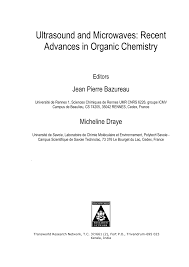Suresh Ganpat Muthe (Assit. Professor, Dept. of Chemistry, Agasti Arts, Commerce and Dadasaheb Rupwate Science College, Akole) Sonochemistry or sound chemistry.... what the matter? Sonochemistry is about the use of ultrasound in chemistry. Indeed,
Read More
Suresh Ganpat Muthe (Assit. Professor, Dept. of Chemistry, Agasti Arts, Commerce and Dadasaheb Rupwate Science College, Akole)
Sonochemistry or sound chemistry…. what the matter?
Sonochemistry is about the use of ultrasound in chemistry. Indeed, power
ultrasound is able to enhance chemical reactivity in a liquid medium
through the generation of cavitation micro-bubbles. The growth and
collapse of these micro-bubbles result in the transfer and focusing of
energy from the macro scale motion of an acoustic transducer to the micro
scale gaseous phase inside the bubbles. During their violent collapse,
extremely high pressures and temperatures are generated in the vapour
phase inside the bubble leading to the production of highly reactive free
radicals, enormous heating and cooling rates and liquid jet streams. This
unique energy focusing mechanism provides a means of reacting
compounds in an aqueous solution and generates energy for interesting
chemical and mechanical effects. The potential applications of this
technology range from surface cleaning to organic synthesis. This first
part of this book (chapters 1 and 2, M. Draye, J.M. Leveque) gives an
overview of the present advances in the use of ultrasound and the potential
of their combination with microwave for organic synthesis.
The chapters concerning sonochemistry are dedicated to Professor
Jean-Louis Luche in recognition of his deep and lasting contributions to
theory and practice of ultrasound for organic synthesis. Professor Luche
has played an important role at the LCME of the University of Savoie
where he has initiated this research topic; enabling practicing scientists to
further develop their own original research through a pioneering research
area.
Since the first report of microwave synthesis in 1981 by Bhargava
Naresh for production of plasticizer esters, the spectacular growth of this
technique is undoubtedly connected to the development of new and
adapted reactors enabling accurate control and reproducibility of the
microwave-assisted organic synthesis procedures but also to the increasing
involvement of pharmaceutical and industrial laboratories. This success is
also due to the fact that microwave heating is instantaneous, very specific
and there is no contact required between the energy source and reaction
reactor.
The objective of the second part of this book is to focus on
different and new fields of applications of this technology in particular
aspects of organic synthesis. In this context, five new fields of
applications have been developed and were written by the most European
eminent scientists, all well recognized in their fields. This book is a
suitable complement of the second edition of the "Microwave in Organic
Synthesis" Wiley-VCH book edited by André Loupy in 2006. In this
"Ultrasound and microwave: recent advances in organic synthesis" book,
the chapter 3 described the synthesis of ionic liquids using solventless
conditions under microwave followed by a survey of several applications
of ionic liquids in organic synthesis (G. Vo-Thanh). In chapter 4,
applications in which microwave-assisted combinatorial approaches on
ionic liquid-phases, liquid- and solid-phases have afforded spectacular
results and applications in medicinal chemistry (J.P. Bazureau). This
chapter is dedicated to Professor Jack Hamelin in recognition of his
important contribution for microwave chemistry in the Chemical
Department of the University of Rennes 1 (as he says: "under microwave,
the best solvent is no solvent", an article of Gavin Whittaker entitled "Fast
and Furious", for New Scientist, published on 28th Feb. 1998).
The next and original topics to be treated are coupling of
microwave activation for reduction reactions in chapter 5 (T. Besson) and
biocatalysis in chapter 6 (V. Thiery). The last chapter 7 (J.J. Vanden Eynde
and D. Barbry) focused on a promising technique under intense
development in industry (cosmetic, pharmacy, essential oils extraction,
etc) is continuous flow chemistry under microwave irradiation. Finally, we
would like to thank all the authors of this book who are at the cutting edge
of their areas of study for their kind contribution to these very stimulating
chapters despite their very busy schedules.
Show Less

